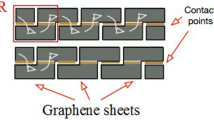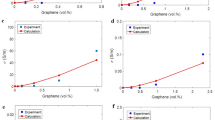Abstract
The effective conductivity of graphene-based nanocomposites is suggested by the characteristics of polymer-filler interfacial areas as well as the contact resistance between the neighboring nanosheets. The interfacial properties are expressed by the effective levels of the inverse aspect ratio and the filler volume fraction. Moreover, the resistances of components in the contact regions are used to define the contact resistance, which inversely affects the effective conductivity. The obtained model is utilized to predict the effective conductivity for some examples. The discrepancy of the effective conductivity at various ranks of all factors is clarified. The interfacial conductivity directly controls the effective conductivity, while the filler conductivity plays a dissimilar role in the effective conductivity, due to the incomplete interfacial adhesion. A high operative conductivity is also achieved by small contact distances and high interfacial properties. Additionally, big contact diameters and little tunnel resistivity decrease the contact resistance, thus enhancing the effective conductivity.
Similar content being viewed by others
Data availability The raw/processed data required to reproduce these findings can be shared as requested from the corresponding author.
References
GHANBARI, S., AHOUR, F., and KESHIPOUR, S. An optical and electrochemical sensor based on L-arginine functionalized reduced graphene oxide. Scientific Reports, 12, 19398 (2022)
ABD EL-KADER, M., AWWAD, N. S., IBRAHIUM, H. A., and AHMED, M. Graphene oxide fillers through polymeric blends of PVC/PVDF using laser ablation technique: electrical behavior, cell viability, and thermal stability. Journal of Materials Research and Technology, 13, 1878–1886 (2021)
AGUILAR-BOLADOS, H., YAZDANI-PEDRAM, M., QUINTEROS-JARA, E., CUENCA-BRACAMONTE, Q., QUIJADA, R., CARRETERO-GONZÁLEZ, J., AVILÉS, F., LOPEZ-MANCHADO, M. A., and VERDEJO, R. Synthesis of sustainable, lightweight and electrically conductive polymer brushes grafted multi-layer graphene oxide. Polymer Testing, 93, 106986 (2021)
CHO, J., LEE, H., NAM, K. H., YEO, H., YANG, C. M., SEONG, D. G., LEE, D., and KIM, S. Y. Enhanced electrical conductivity of polymer nanocomposite based on edge-selectively functionalized graphene nanoplatelets. Composites Science and Technology, 189, 108001 (2020)
WANG, S., MAO, J. J., ZHANG, W., and LU, H. M. Nonlocal thermal buckling and postbuckling of functionally graded graphene nanoplatelet reinforced piezoelectric micro-plate. Applied Mathematics and Mechanics (English Edition), 43(3), 341–354 (2022) https://doi.org/10.1007/s10483-022-2821-8
YANG, S. W., HAO, Y. X., ZHANG, W., YANG, L., and LIU, L. T. Nonlinear vibration of functionally graded graphene platelet-reinforced composite truncated conical shell using first-order shear deformation theory. Applied Mathematics and Mechanics (English Edition), 42(7), 981–998 (2021) https://doi.org/10.1007/s10483-021-2747-9
HU, B., LIU, J., WANG, Y. X., ZHANG, B., WANG, J., and SHEN, H. M. Study on wave dispersion characteristics of piezoelectric sandwich nanoplates considering surface effects. Applied Mathematics and Mechanics (English Edition), 43(9), 1339–1354 (2022) https://doi.org/10.1007/s10483-022-2897-9
FAROUQ, R. Functionalized graphene/polystyrene composite, green synthesis and characterization. Scientific Reports, 12, 21757 (2022)
SHAHID, M., KATUGAMPALAGE, T. R., KHALID, M., AHMED, W., KAEWSANEHA, C., SREEARUNOTHAI, P., and OPAPRAKASIT, P. Microwave assisted synthesis of Mn3O4 nanograins intercalated into reduced graphene oxide layers as cathode material for alternative clean power generation energy device. Scientific Reports, 12, 19043 (2022)
WANG, H., NIU, B., CHEN, M., HAO, L., CAO, X., and JIANG, S. Facile layer-by-layer assembly to construct methoxybenzene group functionalized graphene/poly (ethylene-co-vinyl alcohol) barrier films under parallel electric field. Materials & Design, 118, 226–232 (2017)
VO, N. H., DAO, T. D., and JEONG, H. M. Electrically conductive graphene/poly (methyl methacrylate) composites with ultra-low percolation threshold by electrostatic self-assembly in aqueous medium. Macromolecular Chemistry and Physics, 216, 770–782 (2015)
TU, Z., WANG, J., YU, C., XIAO, H., JIANG, T., YANG, Y., SHI, D., MAI, Y. W., and LI, R. K. A facile approach for preparation of polystyrene/graphene nanocomposites with ultra-low percolation threshold through an electrostatic assembly process. Composites Science and Technology, 134, 49–56 (2016)
HE, L. and TJONG, S. C. Low percolation threshold of graphene/polymer composites prepared by solvothermal reduction of graphene oxide in the polymer solution. Nanoscale Research Letters, 8, 132 (2013)
ZARE, Y. and RHEE, K. Y. Accounting the reinforcing efficiency and percolating role of interphase regions in the tensile modulus of polymer/CNT nanocomposites. European Polymer Journal, 87, 389–397 (2017)
ZARE, Y. and RHEE, K. Y. A simulation work for the influences of aggregation/agglomeration of clay layers on the tensile properties of nanocomposites. JOM, 71, 3989–3995 (2019)
ZARE, Y. and RHEE, K. Y. Significances of interphase conductivity and tunneling resistance on the conductivity of carbon nanotubes nanocomposites. Polymer Composites, 41, 748–756 (2020)
ZARE, Y. and RHEE, K. Y. Effect of contact resistance on the electrical conductivity of polymer graphene nanocomposites to optimize the biosensors detecting breast cancer cells. Scientific Reports, 12, 5406 (2022)
ZARE, Y. and RHEE, K. Y. An innovative model for conductivity of graphene-based system by networked nano-sheets, interphase and tunneling zone. Scientific Reports, 12, 15179 (2022)
MOHAMMADPOUR-HARATBAR, A., ZARE, Y., and RHEE, K. Y. Development of a theoretical model for estimating the electrical conductivity of a polymeric system reinforced with silver nanowires applicable for the biosensing of breast cancer cells. Journal of Materials Research and Technology, 18, 4894–4902 (2022)
FENG, C. and JIANG, L. Micromechanics modeling of the electrical conductivity of carbon nanotube (CNT)-polymer nanocomposites. Composites Part A: Applied Science and Manufacturing, 47, 143–149 (2013)
HU, N., KARUBE, Y., YAN, C., MASUDA, Z., and FUKUNAGA, H. Tunneling effect in a polymer/carbon nanotube nanocomposite strain sensor. Acta Materialia, 56, 2929–2936 (2008)
LIU, Z., PENG, W., ZARE, Y., HUI, D., and RHEE, K. Y. Predicting the electrical conductivity in polymer carbon nanotube nanocomposites based on the volume fractions and resistances of the nanoparticle, interphase, and tunneling regions in conductive networks. RSC Advances, 8, 19001–19010 (2018)
ZARE, Y. and RHEE, K. Y. Development of a conventional model to predict the electrical conductivity of polymer/carbon nanotubes nanocomposites by interphase, waviness and contact effects. Composites Part A: Applied Science and Manufacturing, 100, 305–312 (2017)
ZARE, Y. A simple technique for determination of interphase properties in polymer nanocomposites reinforced with spherical nanoparticles. Polymer, 72, 93–97 (2015)
ZARE, Y. and RHEE, K. Y. Development and modification of conventional Ouali model for tensile modulus of polymer/carbon nanotubes nanocomposites assuming the roles of dispersed and networked nanoparticles and surrounding interphases. Journal of Colloid and Interface Science, 506, 283–290 (2017)
ZARE, Y. Modeling the strength and thickness of the interphase in polymer nanocomposite reinforced with spherical nanoparticles by a coupling methodology. Journal of Colloid and Interface Science, 465, 342–346 (2016)
ZARE, Y., RHIM, S., GARMABI, H., and RHEE, K. Y. A simple model for constant storage modulus of poly (lactic acid)/poly (ethylene oxide)/carbon nanotubes nanocomposites at low frequencies assuming the properties of interphase regions and networks. Journal of the Mechanical Behavior of Biomedical Materials, 80, 164–170 (2018)
KIRMANI, M. H., JONY, B., GUPTA, K., KONDEKAR, N., RAMACHANDRAN, J., ARIAS-MONJE, P. J., and KUMAR, S. Using a carbon fiber sizing to tailor the interface-interphase of a carbon nanotube-polymer system. Composites Part B: Engineering, 247, 110284 (2022)
BAEK, K., SHIN, H., and CHO, M. Multiscale modeling of mechanical behaviors of nano-SiC/epoxy nanocomposites with modified interphase model: effect of nanoparticle clustering. Composites Science and Technology, 203, 108572 (2021)
ZARE, Y. Effects of imperfect interfacial adhesion between polymer and nanoparticles on the tensile modulus of clay/polymer nanocomposites. Applied Clay Science, 129, 65–70 (2016)
ZARE, Y. and RHEE, K. Y. Analysis of critical interfacial shear strength between polymer matrix and carbon nanotubes and its impact on the tensile strength of nanocomposites. Journal of Materials Research and Technology, 9, 4123–4132 (2020)
ZARE, Y., RHEE, K. Y., and PARK, S. J. Predictions of micromechanics models for interfacial/interphase parameters in polymer/metal nanocomposites. International Journal of Adhesion and Adhesives, 79, 111–116 (2017)
WEN, R., KE, K., WANG, Y., YANG, W., XIE, B. H., and YANG, M. B. Interfacial interaction of polyvinylidene fluoride/multiwalled carbon nanotubes nanocomposites: a rheological study. Journal of Applied Polymer Science, 121, 3041–3046 (2011)
ROSTAMI, M., MOHSENI, M., and RANJBAR, Z. An attempt to quantitatively predict the interfacial adhesion of differently surface treated nanosilicas in a polyurethane coating matrix using tensile strength and DMTA analysis. International Journal of Adhesion and Adhesives, 34, 24–31 (2012)
ZARE, Y. and RHEE, K. Y. Crucial interfacial shear strength to consider an imperfect interphase in halloysite-nanotube-filled biomedical samples. Journal of Materials Research and Technology, 19, 3777–3787 (2022)
ZARE, Y. A model for tensile strength of polymer/clay nanocomposites assuming complete and incomplete interfacial adhesion between the polymer matrix and nanoparticles by the average normal stress in clay platelets. RSC Advances, 6, 57969–57976 (2016)
VERMA, S. K., KUMAR, M., KAR, P., and CHOUDHURY, A. Core-shell functionalized MWCNT/poly (m-aminophenol) nanocomposite with large dielectric permittivity and low dielectric loss. Polymers for Advanced Technologies, 27, 1596–1603 (2016)
ISHAK, Z. M., CHOW, W., and TAKEICHI, T. Compatibilizing effect of SEBS-g-MA on the mechanical properties of different types of OMMT filled polyamide 6/polypropylene nanocomposites. Composites Part A: Applied Science and Manufacturing, 39, 1802–1814 (2008)
MESSINA, E., LEONE, N., FOTI, A., DI MARCO, G., RICCUCCI, C., DI CARLO, G., DI MAGGIO, F., CASSATA, A., GARGANO, L., and D’ANDREA, C. Double-wall nanotubes and graphene nanoplatelets for hybrid conductive adhesives with enhanced thermal and electrical conductivity. ACS Applied Materials & Interfaces, 8, 23244–23259 (2016)
LI, J. and KIM, J. K. Percolation threshold of conducting polymer composites containing 3D randomly distributed graphite nanoplatelets. Composites Science and Technology, 67, 2114–2120 (2007)
ZARE, Y. and RHEE, K. Y. A multistep methodology for calculation of the tensile modulus in polymer/carbon nanotube nanocomposites above the percolation threshold based on the modified rule of mixtures. RSC Advances, 8, 30986–30993 (2018)
ZARE, Y. and RHEE, K. Y. Prediction of tensile modulus in polymer nanocomposites containing carbon nanotubes (CNT) above percolation threshold by modification of conventional model. Current Applied Physics, 17, 873–879 (2017)
ZARE, Y. and RHEE, K. Y. Simplification and development of McLachlan model for electrical conductivity of polymer carbon nanotubes nanocomposites assuming the networking of interphase regions. Composites Part B: Engineering, 156, 64–71 (2019)
XU, L., CHEN, G., WANG, W., LI, L., and FANG, X. A facile assembly of polyimide/graphene core-shell structured nanocomposites with both high electrical and thermal conductivities. Composites Part A: Applied Science and Manufacturing, 84, 472–481 (2016)
GAO, C., ZHANG, S., WANG, F., WEN, B., HAN, C., DING, Y., and YANG, M. Graphene networks with low percolation threshold in ABS nanocomposites: selective localization and electrical and rheological properties. ACS Applied Materials & Interfaces, 6, 12252–12260 (2014)
GOUMRI, M., LUCAS, B., RATIER, B., and BAITOUL, M. Electrical and optical properties of reduced graphene oxide and multi-walled carbon nanotubes based nanocomposites: a comparative study. Optical Materials, 60, 105–113 (2016)
TAKEDA, T., SHINDO, Y., KURONUMA, Y., and NARITA, F. Modeling and characterization of the electrical conductivity of carbon nanotube-based polymer composites. Polymer, 52, 3852–3856 (2011)
MAITI, S., SUIN, S., SHRIVASTAVA, N. K., and KHATUA, B. Low percolation threshold in polycarbonate/multiwalled carbon nanotubes nanocomposites through melt blending with poly (butylene terephthalate). Journal of Applied Polymer Science, 130, 543–553 (2013)
AMBROSETTI, G., GRIMALDI, C., BALBERG, I., MAEDER, T., DANANI, A., and RYSER, P. Solution of the tunneling-percolation problem in the nanocomposite regime. Physical Review B, 81, 155434 (2010)
MOHIUDDIN, M. and HOA, S. V. Estimation of contact resistance and its effect on electrical conductivity of CNT/PEEK composites. Composites Science and Technology, 79, 42–48 (2013)
Author information
Authors and Affiliations
Corresponding author
Ethics declarations
Conflict of interest The authors declare no conflict of interest.
Additional information
Project supported by the Basic Science Research Program through the National Research Foundation of Korea (NRF) funded by the Ministry of Education, Science and Technology (No. 2022R1A2C1004437)
Rights and permissions
About this article
Cite this article
Zare, Y., Rhee, K.Y. The roles of polymer-graphene interface and contact resistance among nanosheets in the effective conductivity of nanocomposites. Appl. Math. Mech.-Engl. Ed. 44, 1941–1956 (2023). https://doi.org/10.1007/s10483-023-3046-9
Received:
Revised:
Published:
Issue Date:
DOI: https://doi.org/10.1007/s10483-023-3046-9




